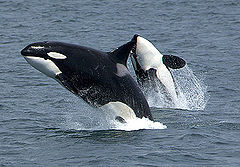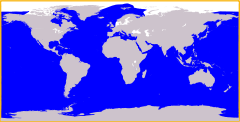- Cosmopolitan distribution
-
In biogeography, a taxon is said to have a cosmopolitan distribution if its range extends across all or most of the world in appropriate habitats. For instance, the killer whale has a cosmopolitan distribution, extending over most of the world's oceans.[1] Other examples include humans, the lichen species Parmelia sulcata and the mollusc genus Mytilus.[1] It may result from a broad range of environmental tolerances,[2][3] or from rapid dispersal compared to the time needed for evolution.[4]
See also
References
- ^ a b Ian F. Spellerberg & John William David Sawyer, ed (1999). "Ecological patterns and types of species distribution". An Introduction to Applied Biogeography. Cambridge University Press. pp. 108–132. ISBN 9780521457125. http://books.google.co.uk/books?id=j3bpQzDz1xkC&pg=PA110.
- ^ S. Kustanowich (1963). "Distribution of planktonic foraminifera in surface sediments of the south-west Pacific". New Zealand Journal of Geology and Geophysics 6 (4): 534–565. http://books.google.co.uk/books?id=_SA4AAAAIAAJ&pg=PA534.
- ^ D. B. Williams (1971). "The distribution of marine dinoflagellates in relation to physical and chemical conditions". In B. M. Funnell & W. R. Riedel. The Micropalaeontology of Oceans: Proceedings of the Symposium held in Cambridge from 10 to 17 September 1967 under the title 'Micropalaeontology of Marine Bottom Sediments'. Cambridge University Press. pp. 91–95. ISBN 9780521187480. http://books.google.co.uk/books?id=cNutoYzqkY8C&pg=PA93.
- ^ Judit Padisák (2005). "Phytoplankton". In Patrick E. O'Sullivan & Colin S. Reynolds. Limnology and Limnetic Ecology. The Lakes Handbook. 1. Wiley-Blackwell. pp. 251–308. ISBN 9780632047970. http://books.google.co.uk/books?id=jsg4Cwp5-C0C&pg=PA285.
Categories:- Biogeography
- Biology stubs
Wikimedia Foundation. 2010.


